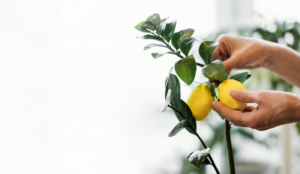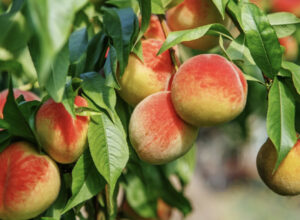How to Take Care of a Lemon Tree: Citrus Paradise

Indoor lemon trees, with their aromatic flowers and shiny leaves, can become an attractive centerpiece in a home. More than just ornamental, these trees yield tangy fruits, turning your effort into a flavorful reward. Regardless of external climatic factors, cultivating a lemon tree indoors in a container is achievable. By understanding its unique requirements, soon you’ll be savoring your own fresh lemonade.
Essential Steps to Growing an Indoor Lemon Tree
- Selecting the Best Lemon Tree for Indoors
- Choosing the Optimal Pot for Your Lemon Tree
- Methodical Planting of Your Lemon Tree
- Ideal Placement for Your Indoor Lemon Tree
- Watering and Nutritional Needs
- Pollination Techniques and Pruning Essentials
Selection Criteria for Indoor Lemon Trees: A Deeper Dive
Selecting the right lemon tree for indoor cultivation isn’t a mere task; it’s an art. While an outdoor lemon tree revels in its natural habitat, thriving under the sun, an indoor lemon tree requires a different set of conditions to flourish. Understanding these subtleties is paramount to ensure that your indoor tree doesn’t just survive, but thrives. Here’s an in-depth look at what you should consider when selecting an indoor lemon tree.
- Size and Growth Pattern: One of the initial aspects to consider is the growth pattern of the tree. Outdoor lemon trees have the luxury of space, reaching soaring heights of up to 20 feet. But indoors, space becomes a premium. Dwarf varieties, specifically designed for indoor conditions, tend to have a compact growth pattern, making them more suitable for confined spaces.
- Early Fruiting: Patience is a virtue, but waiting six years for your indoor tree to bear fruit can test anyone’s limits. Certain grafted varieties are tailored to fruit sooner than their regular counterparts. Such trees are grafted onto special dwarfing rootstocks that accelerate the fruit-bearing age and ensure that the tree remains within a manageable size.
- Adaptability to Indoor Conditions: Not all lemon tree varieties are adaptable to the indoor environment. Some may require excessive sunlight, while others might be too sensitive to indoor temperature fluctuations. Research and opt for varieties known to acclimatize well to indoor conditions.
- Disease Resistance: Indoor trees, due to restricted airflow and potentially consistent moisture, can become more susceptible to certain diseases. It’s crucial to choose a variety that boasts strong disease resistance, ensuring longevity and reducing the need for constant care against pests and diseases.
- Aesthetic Value: While the primary purpose is fruiting, the aesthetic value of the tree cannot be ignored, especially since it’s going to be a part of your living space. Varieties like the Dwarf Variegated Pink Lemonade not only provide tangy lemons but also bring visual appeal with their variegated leaves and distinct fruit color.
- Life Cycle and Yield: Some dwarf varieties, while quick to fruit, might have a shorter lifecycle or might yield fewer fruits over time. It’s essential to understand the expected lifecycle and yield of the tree before making a selection.
- Maintenance Needs: Some lemon tree varieties might be more demanding in terms of care, needing constant pruning or specific light conditions. Choose a tree that aligns with the amount of effort and time you’re willing to invest.
Comparative Table of Common Indoor Lemon Trees
| Lemon Tree Variety | Mature Height | Fruit Yield | Optimal Light Intensity | Watering Frequency | Special Notes |
| Dwarf Improved Meyer | 3-4 feet | High | High (6-8 hours/day) | Moderate | A cross between a lemon and mandarin, sweet and tangy fruit. |
| Dwarf Ponderosa | Up to 6 feet | Medium | Medium-High (5-7 hours/day) | Moderate | A lemon-citron cross, produces large fruits. |
| Dwarf Variegated Pink Lemonade | 4-5 feet | Low-Medium | High (6-8 hours/day) | Moderate-Low | True lemon with green-yellow variegated fruit; pink flesh with clear juice. |
| Standard Indoor Lemon | 5-6 feet | Medium | High (6-8 hours/day) | Moderate | Standard variety; requires more space and care. |
This table is a succinct way to compare and contrast the different lemon tree varieties suitable for indoor growth.
Choosing an Appropriate Pot
Initiating your lemon tree journey with an enormous pot might seem logical, but it’s prudent to start modestly. An excessively large pot complicates moisture assessment. Typically, a 12-inch diameter pot suffices for young nursery-bred trees. As the tree flourishes, one can gradually transition to more spacious pots.
Lemon trees are versatile and can thrive in diverse pots, from breathable terra cotta to contemporary resin designs. Prioritize pots with efficient drainage mechanisms. Additionally, to safeguard indoor surfaces from water spillage, always accompany your pot with a saucer. Given the weight lemon trees can achieve, a wheeled plant stand is a convenient accessory.
Planting Techniques for Indoor Lemon Trees
Planting an indoor lemon tree involves more than just inserting a sapling into soil and awaiting its growth. The technique and precision with which you plant play pivotal roles in determining the tree’s health, fruit-bearing capacity, and longevity. Delve deeper into the intricate details of planting techniques optimal for indoor lemon trees.
- Soil Preparation: One of the foundational aspects of planting is the soil. For indoor lemon trees, a well-draining potting mix designed for citrus trees is paramount. This mix should strike a balance, retaining enough moisture to nourish the tree while preventing waterlogging, which can lead to root rot.
- Container Choice: While the aesthetics of the container play a role, functionality should be the primary focus. A container with efficient drainage holes is crucial to ensure excess water doesn’t stagnate. Start with a modestly sized container when your tree is young and upscale as it grows. The pot’s material also plays a role; while terra-cotta is porous and allows roots to breathe, the plastic retains moisture longer.
- Depth and Positioning: When placing your lemon tree in its pot, it’s vital to ensure the root ball isn’t buried too deep. The flare at the tree’s base, where the roots diverge from the trunk, should be slightly above the soil line. This positioning prevents the trunk from being submerged, reducing the risks of fungal infections.
- Compacting and Watering: Once the tree is in place, gently compress the soil around the base. This ensures that there are no air gaps which can cause roots to dry out. After planting, give the tree a thorough watering to settle the soil and establish initial moisture.
- Root Health Check: Before planting, inspect the tree’s roots. If they’re tightly coiled or show signs of being root-bound, gently tease them out to encourage outward growth. Healthy roots are the lifeline of any tree, and paying attention to them during planting can set the tone for the tree’s future health.
- Initial Nutrient Boost: After planting, it’s beneficial to provide your lemon tree with an initial nutrient boost to kickstart its growth. A plant starter solution rich in micronutrients, specially designed for citrus trees, can help in reducing transplant shock and ensure a robust start.
- Post-Planting Care: Once the tree is planted, don’t place it directly under strong sunlight immediately. Gradually acclimate it to its new surroundings, especially if there’s a significant difference in light intensity from its previous environment.
In essence, planting an indoor lemon tree isn’t just a task; it’s the commencement of a journey. By dedicating attention to the details of planting techniques, you pave the way for a healthy tree that not only adds aesthetic value to your space but also rewards you with delightful citrus treats in due course.
Strategic Placement of Lemon Trees Indoors
Post-planting, the tree’s environment plays a crucial role. Key environmental aspects to consider:
- Light: A daily dose of around eight hours of sunlight is optimal for indoor lemon trees. South or southwest windows usually suffice. If natural light is inadequate, supplemental artificial light can bridge the gap.
- Temperature: Ideally, nighttime temperatures around 65°F are perfect. Lemon trees are sensitive to extreme temperature fluctuations, hence avoid proximity to HVAC outlets.
Effective Watering and Fertilization Regimen
Watering and fertilizing are paramount to the well-being of an indoor lemon tree. The goal is to replicate the tree’s natural environment, providing moisture without over-saturation and essential nutrients to support growth and fruit production.
Understanding the Watering Needs
It’s essential to water your lemon tree only when the top 2-3 inches of the soil are dry to the touch. Over-watering can lead to root rot, a fatal condition for the tree. Employ a consistent watering routine, ensuring that the water reaches deep into the pot, promoting deeper root growth and better stability for the tree. Ensure that your container has proper drainage holes to prevent water stagnation.
The Importance of Fertilization
Indoor lemon trees need a nutrient-rich environment, which is often lacking in regular potting soil. Utilize a balanced citrus-specific fertilizer to provide your tree with the essential nutrients, primarily nitrogen, potassium, and phosphorus. Moreover, micronutrients like magnesium and iron are crucial for the tree’s growth and fruiting capability.
Regularly feeding your tree, especially during its active growth phase, can make a noticeable difference. However, always follow the fertilizer’s label instructions, ensuring you don’t over-fertilize, which could lead to nutrient burn.
Pollination and Pruning Insights
Lemon trees are self-pollinating but can benefit from manual pollination, enhancing fruit yield. Gentle branch shaking during flowering can assist pollen distribution. Regular pruning is seldom needed for indoor lemon trees, but occasional snipping can maintain its aesthetics.

Conclusion
Growing an indoor lemon tree is not only a rewarding gardening endeavor but also an aesthetic and aromatic addition to any indoor space. By selecting the right variety, planting it with care, and meeting its specific needs, you can enjoy a delightful and fruitful experience. With proper attention, your indoor lemon tree will flourish, providing you with fragrant blooms and tangy lemons to savor.
FAQ
1. How long does it take for an indoor lemon tree to bear fruit?
Most dwarf lemon varieties, especially those grafted onto special rootstock, can begin producing fruit in as little as two to three years after planting.
2. Do indoor lemon trees need direct sunlight?
Indoor lemon trees thrive best with about 6–8 hours of sunlight daily. A south or southwest-facing window is ideal. If natural sunlight is inadequate, consider using artificial grow lights.
3. How often should I water my indoor lemon tree?
Watering frequency depends on the soil’s moisture level. Allow the top 3 inches of soil to dry out before watering again. Over-watering can lead to root rot.
4. Do I need to report my lemon tree as it grows?
Yes, as your lemon tree grows, it might become root-bound. It’s a good idea to repot every couple of years or when you notice slowed growth or roots emerging from the drainage holes.
5. Why are the leaves on my indoor lemon tree turning yellow?
Yellowing leaves can be a sign of several issues, including over-watering, under-watering, or nutrient deficiencies. Check the soil’s moisture level and ensure you’re feeding your tree with a balanced fertilizer.




